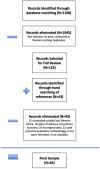Drivers and deterrents of facility delivery in sub-Saharan Africa: a systematic review
- PMID: 23962135
- PMCID: PMC3751820
- DOI: 10.1186/1742-4755-10-40
Drivers and deterrents of facility delivery in sub-Saharan Africa: a systematic review
Abstract
While the most important factors associated with facility-based delivery (FBD) have been explored within individual countries in Africa, no systematic review has explored the factors associated with FBD across sub-Saharan Africa. A systematic search of the peer-reviewed literature was conducted to identify articles published in English from 1/1995-12/2011 that reported on original research conducted entirely or in part in sub-Saharan Africa and included a primary outcome variable of FBD, delivery location, or skilled birth attendance (SBA). Out of 1,168 citations identified, 65 met inclusion criteria. 62 of 65 were cross-sectional, and 58 of 65 relied upon household survey data. Fewer than two-thirds (43) included multivariate analyses. The factors associated with facility delivery were categorized as maternal, social, antenatal-related, facility-related, and macro-level factors. Maternal factors were the most commonly studied. This may be a result of the overwhelming reliance on household survey data - where maternal sociodemographic factors are likely to be well-represented and non-maternal factors may be less consistently and accurately represented. Multivariate analysis suggests that maternal education, parity / birth order, rural / urban residence, household wealth / socioeconomic status, distance to the nearest facility, and number of antenatal care visits were the factors most consistently associated with FBD. In conclusion, FBD is a complex issue that is influenced by characteristics of the pregnant woman herself, her immediate social circle, the community in which she lives, the facility that is closest to her, and context of the country in which she lives. Research to date has been dominated by analysis of cross-sectional household survey data. More research is needed that explores regional variability, examines longitudinal trends, and studies the impact of interventions to boost rates of facility delivery in sub-Saharan Africa.
Figures
References
-
- Lozano R, Wang H, Foreman KJ, Rajaratnam JK, Naghavi M, Marcus JR, Dwyer-Lindgren L, Lofgren KT, Phillips D, Atkinson C, Lopez AD, Murray CJ. Progress towards Millennium Development Goals 4 and 5 on maternal and child mortality: An updated systematic analysis. Lancet. 2011;378(9797):1139–1165. doi: 10.1016/S0140-6736(11)61337-8. - DOI - PubMed
-
- WHO. Making pregnancy safer: The importance of the skilled birth attendant; A joint statement by WHO, ACM, and FIGO. Geneva; 2004.
-
- Wang W, Alva S, Wang S, Fort A. Levels and trends in the use of maternal health services in developing countries. DHS Comparative Reports No. 26. ICF Macro: Calverton, Maryland; 2011.
Publication types
MeSH terms
LinkOut - more resources
Full Text Sources
Other Literature Sources
Medical
Molecular Biology Databases
Miscellaneous


